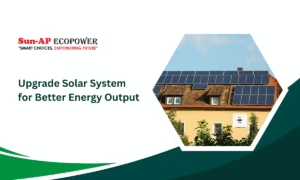In an era where renewable energy takes center stage in the global push for sustainability, solar power plants stand as beacons of hope and progress. With their vast capacities and cutting-edge technologies, these solar parks are redefining the way we generate electricity while contributing significantly to the reduction of carbon emissions. As the world grapples with the challenges of climate change and the need to transition from fossil fuels, these five colossal solar power plants are leading the charge in harnessing the power of the sun to create a greener and more sustainable future.
Solar power plants are emerging as critical contributors to the global energy transition as demand for clean and sustainable energy grows. These magnificent solar parks represent a great success in massively harnessing the sun’s energy. In this blog, we’ll look at the world’s five largest solar power plants – Bhadla Solar Park in India, Huanghe Hydropower Hainan Solar Park in China, Pavagada Solar Park in India, Benban Solar Park in Egypt, and Tengger Desert Solar Park in China – and learn about their impressive features and contributions to renewable energy.
1. Bhadla Solar Park, India:
Location: Rajasthan, India
Total Capacity: Over 2,245 megawatts (MW)
Bhadla Solar Park, located in India’s arid state of Rajasthan, is a large solar power complex that has established India as a key player in the solar energy market. The park is divided into phases, each with a large capacity, and spans thousands of acres of land.
Key characteristics include:
- Bhadla Solar Park’s massive size makes it one of the world’s largest solar power facilities, capable of powering millions of homes.
- Solar Irradiance: Rajasthan’s strong solar irradiance provides year-round energy generation.
- The park matches India’s ambitious renewable energy ambitions, contributing to the country’s resolve to cut carbon emissions.
- The Huanghe Hydropower Hainan Solar Park in China exemplifies the country’s resolve to switch to clean energy sources. This solar park is an amazing example of mixing renewable energy with hydroelectric power, making it a cutting-edge and environmentally friendly energy facility.
2. Huanghe Hydropower Hainan Solar Park, China:
Location: Hainan, China
Total Capacity: Over 2,200 megawatts (MW)
Key characteristics include:
- Hybrid Energy System: By combining solar and hydroelectric electricity, a consistent and predictable energy supply is created, with each system compensating for the variations of the other.
- Sustainable Synergy: This one-of-a-kind combo cuts reliance on fossil fuels while minimising environmental impacts.
- Environmental Protection: The solar park cuts greenhouse gas emissions significantly, aiding China’s efforts to battle climate change.
3. Pavagada Solar Park, India:
Location: Karnataka, India
Total Capacity: Over 2,050 megawatts (MW)
The Pavagada Solar Park in India’s sun-drenched state of Karnataka is one of the largest solar power parks in Asia. Because of its large capacity and excellent location, it has become an important role in India’s ambitious renewable energy aspirations.
Key characteristics include:
- Large-Scale Capacity: Pavagada Solar Park’s huge capacity is critical to India’s ambition to boost the share of renewable energy in its energy mix.
- Land Utilisation: Because the park is located in semi-arid land, it can make efficient use of land resources that would otherwise be wasted.
- Economic Development: The solar park has brought economic development to the region, producing jobs and stimulating the local economy.
4. Benban Solar Park, Egypt:
Location: Aswan Governorate, Egypt
Total Capacity: Over 1,800 megawatts (MW)
The Benban Solar Park in Egypt is an outstanding project that demonstrates the country’s dedication to renewable energy despite its past reliance on fossil fuels. This massive solar installation is altering Egypt’s energy landscape and paving the road for a more environmentally friendly future.
Key characteristics include:
- Foreign Investment: Significant foreign investments have been made in the Benban Solar Park, supporting technology transfer and improving Egypt’s renewable energy infrastructure.
- Diversification: The solar park diversifies Egypt’s energy mix, lowering the country’s reliance on fossil resources and increasing energy security.
- Sustainable Development: The solar park contributes to sustainable development and environmental conservation by reducing carbon emissions and boosting clean energy.
5. Tengger Desert Solar Park, China:
Location: Tengger Desert, China
Total Capacity: Over 1,500 megawatts (MW)
Tengger Desert Solar Park in China’s dry Tengger Desert shows the country’s leadership in renewable energy production. This massive solar farm has set energy production records and has become a symbol of China’s dedication to sustainability.
Key characteristics include:
- Desert Land Use: The park effectively uses enormous tracts of desert land that would otherwise be underutilised, demonstrating the potential of solar electricity in non-agricultural settings.
- Tengger Desert Solar Park is an important part of China’s continuing energy revolution, which is moving from fossil fuels to renewable energy sources.
- International Collaboration: The solar park has sparked international interest, allowing for knowledge sharing and technological breakthroughs in the solar energy sector.
A final ode to conclude
The visit of the world’s five largest solar power facilities has been an inspirational tour of cutting-edge technology, imaginative thinking, and a shared commitment to constructing a sustainable future. These solar megastructures are more than simply power plants; they represent our collective commitment to embracing better energy choices, lowering carbon emissions, and mitigating the effects of climate change.
In Conclusion, the world’s five largest solar power plants are not just architectural wonders, but also examples of human creativity and our joint obligation to protect the earth for future generations. As the global energy landscape evolves, these solar megastructures will act as guiding lights, illuminating the route to a more sustainable, resilient, and harmonious world fueled by the sun’s limitless energy. We can continue to build on these achievements by harnessing the sun’s boundless power and driving the global energy revolution towards a greener, more sustainable future.
Role of Sun-AP EcoPower in the Solar Energy Journey:
Companies like Sun-AP Eco Power are at the forefront of solar innovation in the fight for a sustainable energy future, playing a critical role in expanding the adoption of clean energy solutions. Sun-AP Eco Power, a leading solar distributor, is dedicated to pushing the boundaries of solar technology, fostering research and development, and accelerating the worldwide energy revolution. Sun-AP has been a leading official distributor for brands like Panasonic, DEYE, Adani, Enphase, DEIF, Livguard, Sakthi, and more.
Together, we can build a world in which the sun’s boundless energy illuminates our path to a healthy, resilient, and sustainable future for future generations.
Join Sun-AP Eco Power in the solar revolution today to take the first step towards a more sustainable future!




